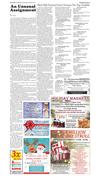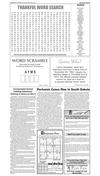112718_YKBP_A9.pdf




November 27, 2018 www.broadcasteronline.com
Broadcaster Press 9
Concentrated Animal
Feeding Operations
Training in Huron on Dec 5
Pertussis Cases Rise In South Dakota
PIERRE, S.D. – Recent reports of community increases in
pertussis have the Department of Heath reminding parents
to make sure their kids are appropriately immunized.
Since the beginning of the year, 90 cases of pertussis
BROOKINGS, S.D. - SDSU Extension hosts an environmental
training session for operators of Concentrated Animal Feeding have been reported to the Health Department. This is the
Operations (CAFO), policy makers and concerned citizens. The highest number reported since 2014 when the state saw 109
pertussis cases. Counties seeing the most cases include Edtraining will be held December 5, 2018, in Huron at the Crossmunds (19), Brown (15), Minnehaha (13), and Hughes (12).
roads Convention Center (100 Fourth St. S.W.).
“Pertussis is a very serious illness so it is important to
To register, visit iGrow Events and search by training date.
take precautions like ensuring you and your children are
Registration begins at 8:30 a.m. in Huron. To cover the cost of
current with all recommended vaccines,” said Dr. Joshua
the event, registration is $50 and includes lunch, breaks and
training materials. Due to room availability, registration will be Clayton, state epidemiologist for the department.
Book 66
Challenging Sudoku Puzzles
Pertussis is a highly contagious diseaseby KrazyDad
that is spread
limited to the first 60 people for this training.
from person to person through the air by the cough of an
The program begins at 8:50 a.m. and concludes at approxiinfected person. Early symptoms resemble a common cold,
mately 4:45 p.m. Sudoku #5
Sudoku #6
Specialists from SDSU Extension, the South Dakota Depart- including sneezing, runny nose, low-grade fever and a mild
4
7 cough. Within two weeks, the cough becomes more severe
7 2
5
ment of Environment and Natural Resources, and the Natural
and is characterized by episodes of numerous rapid coughs
Resources Conservation Service are offering the training.
3
9 followed by a high-pitched whoop. Thick, clear mucus may
1 4
Training fulfills 7
permitting requirement 2
In the Spring of 2017, the S.D. Department of Environmental be discharged following the cough. Coughing episodes may
3
5
4 3
at
and Natural Resources reissued the General Water Pollution 4 recur for one to two months, and are more frequent 2 night.
While it can affect people of any age, it is most severe
Control Permit for Concentrated Animal Feeding Operations.
6
2 in babies under 6 months old, especially in preterm and
8
9
1
The new permit requires existing permitted operations to obtain coverage under the9
proposed permit between one to1
four unvaccinated infants. The elderly are also at risk. The single
3
7
most effective control measure is maintaining the highest
years after the General Permit is issued.
possible level of immunization in the community. The vacOne of the proposed4
permit conditions for existing permit8
5
3
6
cine is given in a series of doses at 2, 4, 6 and 15 months of
ted operations is that an onsite representative attends an
at
approved environmental training program within the last three8 age and 6 4–6 years of age. Because immunity wanes over
2 66: Answers
6
8 1
Book
time, aIntermediate dose is recommended for adolescents, 11-12
booster Sudoku Puzzles by KrazyDad
years prior to obtaining a new permit. Also, if the person who
Sudoku #2
attended training no longer works at the 9
8 Sudoku6#12 operation, another 5 years of age, and for 8adults. 1 shorten the contagious pe7 79148
6
3 5
2 antibiotics can
6 3 9 4
Treatment 7with 1 5
representative must attend training within one year.
2 5 7 8 6 1 4 9 3
8 7 9 4 5 1 3 6 2
5 6 9 5 require8
9 7
This current training6
program meets8the training 7
4 8 1 3 9 5 6 2 7
4 1 2
3
© 2008 KrazyDad.com
ment of the proposed permit as 5 9 8 7 is attended 2008 KrazyDad.com 1 6 8 2 5 7 9 3 4
long as it 1 4 2 3 © within
6
1 3 7
2 5 8 9 4
7 2 3 9 4 8 5 6 1
three years of obtaining coverage under6 the new permit. Ma3 7 1 5
9 4 5 6 1 3 roadcaster ress
2 7 8
6 other
nure applicators, producers and2 any 4 9 8interested individu6
5 7 2 1 3 9 8 4 6
als who are not currently applying 8 3 a5 9 7 4 2 also benefit
for permit can 1
Fill the puzzle so that every row, every column, and every
7 4 1 3 6 2 5 8 9
3 9 4 5 8 6 7 1 2
from the information and are encouraged to attend. 3
section6contain4the numbers 1-9 without repeating a number.
9 2 5 1 4 8 6 7
8 1
7
Sudoku #7
Sudoku2 #8 3 5 9
Certified Crop Advisor credits are available as well.
Speaker line-up & presentation details
6 Sudoku #3
5
6 9
Sudoku #4 8
John McMaine, Assistant Professor & SDSU Extension Water
1 3 5 8 4 9 7 2 6
4 1 2 6 9 7 8 5 3
4
6 2 quality.
5
Management Engineer will discuss7water6 1 3 9 8
5
8 7 9571 38462
2
1
2 8 9 6 7 3 4
5
8 3 6 4 2 5 9 1 7
Bob Thaler, Professor & SDSU Extension Swine1Specialist
8 9 2 7 1 4 5 6 3
7 6 8 3 1 9 2 4 5
3 4
3 6
7
will lead a session on livestock nutrition options for 2
reducing
3 4 1 8 5 2 7 9 6
3 6 4 5 2 8 9 7 1
nitrogen and phosphorus content of manure. 8 4 2
5 2 9 7 4 6 3 8 1
7 5 1 9 3 6
55 1 8 4 6 7 7 3 the 3
1
8 3
Jason Roggow, a natural resources engineer 2with 9 South
1 9 4 2 6 3 5 7 8
Dakota Department of Environment and3Natural Resources,
6 2 7
9 5 1 8 4
2 8 5 9 7 1 6 3 4
9
1 67358 412 9
9 4 3 1 8 2 6 5 7
will give an overview of the South Dakota DENR Livestock
Permit program.
2 Sudoku Field
6
4
2 4
9
Sudoku #6
Anthony Bly, SDSU Extension Soils #5 Specialist, will
6 1 2 8 9 3 7 4 5
8 5 4 2 3 6 1 9 7
discuss managing nitrogen and phosphorus in land applica44 5 9 1 5 7 3 8 6
5
3 9
2
3
3 2 9 1 7 8 6 5 4
tions of manure.
3 8 7 4 6 5 2 9 1
1 7 6 5 4 9 8 2 3
Jason Gilb, Conservation Agronomist 9 2 the 3 4 Natu- 8
7 6
5
8 USDA
4 9 4 3 8 2 7 6 18
5
2 1 12 3 8 9 with4 6 5 9
ral Resources Conservation Service will7go through nutrient
1
2 1 3 6 5 7 4 8 9
9
7 6 8 9 1 4 2 3 5
management planning worksheets.4 5 6 3 8 1 2 7
9
3 7
1 6
8 6 3 5 7 9 4
2
5 4 7 8 6 3 9 1 2
John Lentz, Resource Conservationist with the1USDA Natu© 2008 KrazyDad.com
© 2008 KrazyDad.com
5 2 1 3 4 6 9 7 8
9 8challenging 6
1 4 2 5 3 7
ch BOOK 66 #8
ral Resources Conservation Service will2cover implementing
7 9 4
8 1 5 6 3
6 3 2 7 9 1 5 4 8
conservation practices to improve sustainability.
Last tuesday’s
Kent Vlieger, Soil Health Specialist with the USDA Natural
Sudoku #7
Sudoku Solution
#8
Resources Conservation Service, will4demonstrate soil erosion
7 3 1 9 5 6
8 2
1 3 5 2 4 8 9 6 7
KRAZYDAD.COM/PUZZLES
and infiltration.
5 7 1 8 9 6 2 4 3
6 8 9 5 1 7 3 2 4
9 6 3 2 4 5 8
7
7 4 2 3 6 9 1 5 8
Bob Thaler, Professor & SDSU Extension Swine1Specialist,
© 2008 KrazyDad.com
2 5 7 9 3 1 4 8 6
7 5 8 9 2 4 3 6
will conclude the day's training with a session on air1quality
1 4 9 6 7 3 5 2 8
4 9 3 6 8 5 7 1 2
check next Tuesday’s paper for
and odor.
6 3 2 1 5 8 7 9 4
8 1 6 7 2 4 5 9 3
"Past attendees of this program9have come away5
3
7 4 1 2 6 8 with at
5 2 1 8 7 3 6 4 9
the solution to today’s puzzle.
least one new practice they consider6 5 8 7 related to land
2 1 adopting 4 3 9
9 7 8 4 5 6 2 3 1
4 8 5 3 6 9
7 2
3 6 4 1 9 2 8 7 5 int BOOK 66 #8
application, livestock feeding, air quality or soil1conservation,"
Thaler said.
bpp
b
Since 1934
Since 1934
Broadcaster Press
P
B
bp Broadcaster
bp B
Since 1934
Since 1934
Press
roadcaster
Press
su do ku
riod. People who have been in contact with an infected person should see their clinician for evaluation and to receive
antibiotics if they have symptoms of pertussis or are at high
risk of developing pertussis. People at high risk of developing pertussis following exposure to a pertussis case include
household contacts, infants, pregnant women in their third
trimester, and persons with pre-existing health conditions.
People not having symptoms and not at high risk of
developing pertussis should monitor themselves for respiratory symptoms for 21 days. To prevent the spread of disease,
people with pertussis or their symptomatic contacts may be
isolated at home. More information about pertussis and its
control can be found on the department’s website at http://
doh.sd.gov/diseases/infectious/diseasefacts/Pertussis.aspx.
Stories you missed this week because
you’re not a Plain Talk subscriber
A closer look at what’s in store for downtown Vermillion and its third
annual Stand-Still Parade of Lights.
A report about policy changes the Vermillion City Council will be
considering as new requirements have been issued for the way that
municipalities administer federal grant funds they receive.
Advice from Irene-Wakonda kindergarteners on how to cook a
holiday turkey.
And if you want to see:
A story about the reissuance of alcohol beverage licenses to bars
and businesses in Vermillion, with a review from the Vermillion Police
Department on how well they are dealing with the challenge of not
serving minors who are using more sophisticated forms of false
identification.
A report about the upcoming Christmas on the Missouri that
will be presented in early December by churches in Vermillion.
Different choral and solo pieces, along with narration, showcase
the Christmas story. Each year the concert ends with everyone
sing Hallelujah Chorus from Messiah by G. F. Handel. On display
following the concert are creches, which are nativity scenes, brought
by members of the various churches.
Coverage of recent discussion about the community’s use of the
Prentis Plunge aquatic facility, the expenses the city has experienced
in operated the facility and plans for a rate increase to help meet
those expenses.
Pick up this Friday’s Plain Talk!
Local news since 1884!
Here for you yesterday, today and tomorrow.
201 W. Cherry, Vermillion, SD 57069
605-624-2695















 Previous Page
Previous Page






